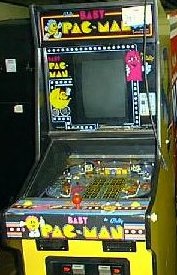A Historical Look at Video Games


The Ancestry of the Arcade
The Birth of the Video Game
On the Go and in the Home
Early Arcade Classics
Competition on the Home Front
Video Games: A Cultural Movement
The Downward Spiral

Baby Pac Man Arcade Machine
Back on the arcade front, several major advancements in video technology were underway. Exidy created the first four-color video game, Star Fire; the first vector graphics appeared on a game called Space Wars. Making its debut at the 1979 Amusement and Music Operators Association Convention (AMOA) was Grogar, the first talking game. The digitized voice uttered eight different phrases, making it the news of the industry. Atari's Asteriods also arrived at the arcades, followed closely by Missile Command. A year later, they followed these classics with Battle Zone, the first 3-D arcade game.
The early eighties were a banner period for stand-up arcade manufacturers. Companies like Williams, Bally, and Midway were making a name for themselves with hit after hit. In their search for new and exciting titles, Hank Ross of Bally traveled to the offices of Nameco in Japan. Nameco explained they were anticipating a game they felt was sure to be a success, but it was not yet complete. In the meantime, they had two so-so games that were ready. While waiting for the completion of Rally X, Nameco showed him Pac Man and Shoot Away; the rest is history. Originally named Puck Man (the name was changed in anticipation of alterations to the lettering), Pac Man went on to become the biggest selling arcade game in history, spawning several spin-offs like Ms. Pac Man, Pac Man Jr., Super Pac Man and Pacmania.
1981 proved to be a great year for Williams. They released the first side-scrolling video game, Defender, in February. It quickly sold more than 50,000 units, shooting Williams to the third largest manufacturer position in the arcade market and giving them their most profitable year in their forty year history. Later that year, they produced Robotron 2084, the first dual joystick game, which was voted Best Action Coin-op of the year. At the same time, Atari was introducing a new style of game incorporating graphics created by a series of straight, brightly colored lines against a black background. Tempest was the first color vector-monitor game to appear in amusement centers, but several imitators would soon hit the market.
